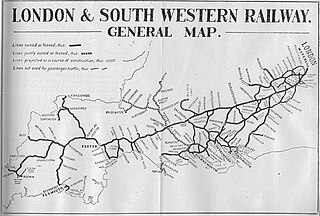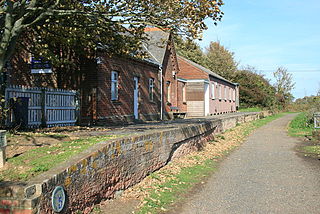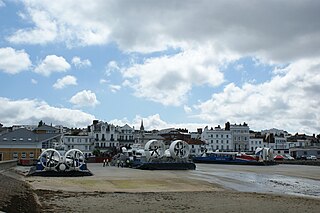
Newhaven is a port town in the Lewes district of East Sussex, England, lying at the mouth of the River Ouse.

The London and South Western Railway was a railway company in England from 1838 to 1922. Originating as the London and Southampton Railway, its network extended to Dorchester and Weymouth, to Salisbury, Exeter and Plymouth, and to Padstow, Ilfracombe and Bude. It developed a network of routes in Hampshire, Surrey and Berkshire, including Portsmouth and Reading.

The Southern Railway (SR), sometimes shortened to 'Southern', was a British railway company established in the 1923 Grouping. It linked London with the Channel ports, South West England, South coast resorts and Kent. The railway was formed by the amalgamation of several smaller railway companies, the largest of which were the London and South Western Railway (LSWR), the London, Brighton and South Coast Railway (LB&SCR) and the South Eastern and Chatham Railway (SE&CR). The construction of what was to become the Southern Railway began in 1838 with the opening of the London and Southampton Railway, which was renamed the London & South Western Railway.

The London, Brighton and South Coast Railway was a railway company in the United Kingdom from 1846 to 1922. Its territory formed a rough triangle, with London at its apex, practically the whole coastline of Sussex as its base, and a large part of Surrey. It was bounded on its western side by the London and South Western Railway (L&SWR), which provided an alternative route to Portsmouth. On its eastern side the LB&SCR was bounded by the South Eastern Railway (SER)—later one component of the South Eastern and Chatham Railway (SE&CR)—which provided an alternative route to Bexhill, St Leonards-on-Sea, and Hastings. The LB&SCR had the most direct routes from London to the south coast seaside resorts of Brighton, Eastbourne, Worthing, Littlehampton and Bognor Regis, and to the ports of Newhaven and Shoreham-by-Sea. It served the inland towns and cities of Chichester, Horsham, East Grinstead and Lewes, and jointly served Croydon, Tunbridge Wells, Dorking and Guildford. At the London end was a complicated suburban and outer-suburban network of lines emanating from London Bridge and Victoria, and shared interests in two cross-London lines.

The Isle of Wight Railway was a railway company on the Isle of Wight, United Kingdom; it operated 14 miles of railway line between Ryde and Ventnor. It opened the first section of line from Ryde to Sandown in 1864, later extending to Ventnor in 1866. The Ryde station was at St Johns Road, some distance from the pier where the majority of travellers arrived. A tramway operated on the pier itself, and a street-running tramway later operated from the Pier to St Johns Road. It was not until 1880 that two mainland railways companies jointly extended the railway line to the Pier Head, and IoWR trains ran through, improving the journey arrangements.

The Lymington branch line is a railway that runs from Brockenhurst to Lymington in the New Forest, England. The line is around 5.6 miles (9 km) long, and is single track throughout its length. It diverges from the South West Main Line at Lymington Junction. At Lymington Pier, trains connect with Wightlink ferry services to Yarmouth, Isle of Wight. The Lymington branch line is electrified using the 750 V DC third-rail system.

Brighton railway works was one of the earliest railway-owned locomotive repair works, founded in 1840 by the London and Brighton Railway in Brighton, England, and thus pre-dating the more famous railway works at Crewe, Doncaster and Swindon. The works grew steadily between 1841 and 1900 but efficient operation was always hampered by the restricted site, and there were several plans to close it and move the facility elsewhere. Nevertheless, between 1852 and 1957 more than 1200 steam locomotives as well as prototype diesel electric and electric locomotives were constructed there, before the eventual closure of the facility in 1962.

Ryde Pier Head railway station is one of three stations in the town of Ryde on the Isle of Wight. Situated at the end of the town's pier, it is adjacent to the terminal for the Wightlink fast catamaran service connecting the island with Portsmouth on the English mainland. Passengers can use this to connect with the rest of the National Rail network at Portsmouth Harbour station, which is adjacent to the Portsmouth terminal. Through rail tickets for travel via Pier Head station are available to and from other stations on the Isle of Wight. These include travel on the catamaran service to or from Portsmouth as appropriate.

The LB&SCR K class were powerful 2-6-0 mixed traffic locomotives designed by L. B. Billinton for the London, Brighton and South Coast Railway (LB&SCR) in 1913. They appeared shortly before the First World War and the first ten examples of the class did prodigious work during that conflict on munitions, supply and troop trains. Further examples were built after the war, and the class was used as a test bed for various items of specialised equipment. However, after the formation of the Southern Railway in 1923 the remaining three locomotives on order were not completed and the seventeen members of the class led relatively quiet yet reliable lives over their traditional lines. The locomotives proved their usefulness once again during the Second World War, and continued to provide reliable service until the 1960s. The entire class was eventually withdrawn in 1962 for 'bookkeeping' rather than 'operational' reasons.
Robert John Billinton was the Locomotive, Carriage, Wagon and Marine Superintendent of the London, Brighton and South Coast Railway from 1890 until his death.
Douglas Earle Marsh (1862–1933) was an English railway engineer, and was the Locomotive, Carriage and Wagon Superintendent of the London, Brighton and South Coast Railway from November 1904 until his early retirement on health grounds in July 1911.
Lawson ButzkopfskiBillinton was the Locomotive Engineer of the London, Brighton and South Coast Railway from 1912 until the company became part of the Southern Railway in 1923. He joined the LBSCR in 1900 as an apprentice. By the end of 1907 he was a district locomotive superintendent at the railway works at New Cross. From February 1911 Billinton was locum tenens, or caretaker, for Locomotive Engineer D. E. (Earle) Marsh at Brighton works whilst Marsh was on leave of absence due to ill health. Earle Marsh resigned in July 1911. Billinton was promoted to Locomotive Engineer at the beginning of 1912.

The LB&SCR L Class was a class of 4-6-4 steam tank locomotives designed by L. B. Billinton for the London, Brighton and South Coast Railway. They were known as the "Brighton Baltics", Baltic being the European name for the 4-6-4 wheel arrangement. Seven examples were built between April 1914 and April 1922 and they were used for express passenger services.

Freshwater railway station was the westerly terminus and largest station of the Freshwater, Yarmouth and Newport Railway, the platform being extended to accommodate the "Tourist Train", a non-stop service from Ventnor.

Yarmouth railway station, was an intermediate station of the Freshwater, Yarmouth and Newport Railway.

Ningwood railway station, was an intermediate station of the Freshwater, Yarmouth and Newport Railway, incorporated in 1860.

There are currently three different ferry companies that operate vessels carrying passengers and, on certain routes, vehicles across the Solent, the stretch of sea that separates the Isle of Wight from mainland England. These are Wightlink, Red Funnel and Hovertravel.
Brittany was a 631 GRT passenger ferry built in 1910 for the London, Brighton and South Coast Railway. In 1912 she was sold to the London and South Western Railway, passing to the Southern Railway on 1 January 1923. She was renamed Aldershot in 1933. In 1937 she was sold to an Italian owner and renamed Hercules. On 24 November 1941, she was torpedoed and sunk by HMS Triumph.

The Port of Newhaven is a port and associated docks complex located within Newhaven, East Sussex, England, situated at the mouth of the River Ouse.

This article describes the shipping services of the London and South Western Railway and the vessels employed.
















